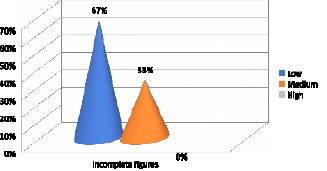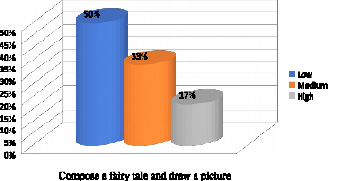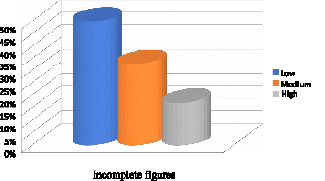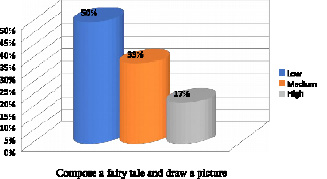Educating creative people capable of non-standard original solutions in any life situation is the dictate of modern education. Artistic and visual activity has a huge potential for the formation of creative activity in children.
The visual activity of preschoolers as a type of artistic activity should be emotional and creative. A teacher-educator must create all conditions for this: he is primarily obliged to provide an emotional, imaginative perception of reality, to form aesthetic feelings and ideas, to develop imaginative thinking and imagination, to teach children how to create images, the means of their expressive performance. The learning process should be aimed at the development of children’s visual creativity, at the creative reflection of impressions from the surrounding world, works of literature and art. The use of non-traditional drawing techniques is of great importance for the development of creative activity of preschool children.
The purpose of the study is to consider the problem of the development of cognitive activity of older preschoolers in visual activities.
Materials and methods of research
The problem of the development of children’s creativity is described in the studies of a number of teachers and psychologists L.S.Vygotsky, L.G. Vasilyeva, N.A. Vetlugina, V.V. Davydova, T.S. Komarova, etc.
The most crucial period in a person’s life is preschool age, since it is at this age that the foundations of harmonious personal development are organized, moral and mental qualities are formed. Unique opportunities and creative activity develop in the process of creative activity, and are one of the most important tasks of a preschool educational organization.
The Federal State Educational Standard of Preschool Education (Order No. 1155 of 10/17/13) identifies two educational areas (clause 2.6) that involve the development of creative activity in preschool children [1].
The educational field “Cognitive development” includes “the development of children’s interests, curiosity and cognitive motivation; the formation of cognitive actions, the formation of consciousness; the development of imagination and creative activity; the formation of primary ideas about oneself, other people, objects of the surrounding world (shape, color, size, material, quantity, number, space and time, etc.)” [1].
The educational field “Artistic and aesthetic development” presupposes the development of prerequisites for “value-semantic perception and understanding of works of art (verbal, musical, visual); the formation of an aesthetic attitude to the surrounding world; stimulating empathy for the characters of works of art; the implementation of independent creative activity of children (visual, constructive-model, musical, etc.)” [1].
The requirements for the organization of pedagogical conditions for the artistic and creative development of preschoolers are prescribed in the Federal State Educational Standard:
– the use of forms and methods of working with children in educational activities that correspond to their age and individual characteristics;
– building educational activities focused on the interests and capabilities of each child;
– support of initiative and independence of children in their specific activities;
– the possibility for children to choose materials, types of activities, participants in joint activities [1].
The problem of the formation of an active creative personality is currently particularly relevant. At preschool age, children undergo education, socialization, and training in preschool institutions, where teachers use different techniques for the development of the child.
At the senior preschool age, cognitive and creative activity begins to form. Activity, according to L.S. Vygotsky, is a practical subject-sensory activity aimed at transforming the surrounding world and the personality itself – the most important condition and factor of its mental development. The following essential generic signs of activity can be distinguished: quality, activity (process and result), readiness [2].
The basis for studying the cognitive activity of preschoolers is the cognitive need of the child himself, his interest in a new object.
N.N. Poddyakov identifies “three levels of cognitive activity in preschoolers:
– the level of interest in the external properties of the subject is determined by the subject itself;
– the level of interest in the functional qualities of the subject and the regulation of the search is determined with the help of an adult;
– activity is directed by the goal – to achieve the desired result” [3].
The implementation of the content of education includes not only the formation of a set of knowledge, skills and abilities, but also a creative component in working with preschoolers, in particular, with older preschool children. Older preschoolers are capable of proactive transformative activity, feel the need to create, transform something, can emotionally anticipate the results of their activities, experience emotions of the highest order (moral, cognitive, aesthetic) [4].
What is creative activity? According to L.G.Veselova, “Creative activity is understood as “... the realization of the need for new knowledge and receiving positive emotions from them, as well as the ability to transform, modify existing knowledge and express one’s own attitude to them in various types of artistic and creative activity ...” [5.p.6].
According to Yu. N. Ryumina, creative activity is “an active state of personality characterized by the desire to transform something, to create a personally significant material or spiritual product”
Let’s consider the features of creative activity. No activity of a creative nature is intolerable without the inclusion of the creative activity of the subject, the inner nature of which is recognized as the dominant in creativity. The concept of “creative activity” in pedagogy and psychology is discussed far from unambiguously and is understood as:
a) motivated readiness for activity, orientation of the subject;
b) the level of intensity of a person’s involvement in creative activity, as an aspiration and a measure of a person’s efforts;
c) property, personal education, personality quality, criterion, indicator and prerequisite of creativity and creativity.
To identify the level of development of creative activity and creative potential of children of senior preschool age, we used the methodology of E. Torrens “Incomplete figures”, “Compose a fairy tale and draw a picture” (O.M.Dyachenko).
The “Incomplete Figures” technique activates the activity of the imagination, revealing one of the skills – to see the whole before the parts. The child perceives the proposed test figures as parts, details of any integrity and completes, reconstructs them. The task of drawing figures is one of the most popular in the study of the features of imagination, creative abilities of preschoolers, the level of formation of cognitive activity. The children were asked to finish the figures depicted on the sheet: a square, a triangle, a circle – so that a meaningful image of an object would turn out. Moreover, the attention of the children was drawn to the fact that the finishing can be carried out both inside the contour of the figure and outside it with any rotation of the sheet and the image of the figure convenient for the child, i.e. each figure can be used in different angles.
According to the results of the diagnosis, a low level of creative activity and creativity was revealed in 67 % of children, an average level – in 33 % of children, there were no children with a high level (see Figure 1).

Fig. 1. Results of the primary diagnosis of senior preschoolers on the Torrens test “Incomplete figures”

Fig. 2. The results of the primary diagnosis of older preschoolers according to the method “Compose a fairy tale and draw a picture”
According to the diagnostic results, a high level was detected in 17 % of children, an average level in 33 %, and a low level in 50 % of children. Most of the children told and depicted famous fairy tales, only one child came up with his own fairy tale.
At the formative stage of the study, we developed and implemented a system of classes for the development of cognitive activity. The methods of non-traditional drawing were used in the classroom. Children learned to get images with their fingers, various ways of printing, from a blob, to depict lines, shapes. Consider some unconventional drawing techniques:
Poke with a stiff, semi-dry brush. Job description: the child puts a brush in gouache and hits it on the paper, holding it vertically. When working, the brush does not sink into the water. Thus, the entire sheet is filled in before receiving. imitations of a fluffy or prickly surface.
Spray. The method of obtaining the image: the child dials the paint on the brush and hits the brush on the cardboard, which he holds over the paper. The paint splashes onto the paper.
Candle + watercolor. First, the child draws a drawing with a candle on paper. Then he paints the sheet with watercolor in one or more colors, the candle pattern remains white.
Blotting. The child scoops gouache with a plastic spoon and pours gouache stains on the paper. A clean sheet of paper should be applied to the spots and pressed. Next, the top sheet is removed, the image is examined: it is determined what it looks like. The missing details are being drawn.
Grattage. Children are taught to rub a sheet with a candle so that it is all covered with a layer of wax and pour gouache After drying, the drawing is scratched with a stick. The children really liked the classes “Starry Night” (candle + watercolor), “Trees look into the lake” (monotype), “Fairy Tree” (Blowing (blowing with a straw), “Peacock from palms”, “Portrait of a Soap Bubble”, “Cosmos”, etc. Classes contributed to the development of cognitive activity, creativity, imagination.
Results and their discussion
At the control stage of the study, we performed the same diagnostics as at the ascertaining stage of the study. The results showed positive dynamics.

Fig. 3. Results of diagnostics of senior preschoolers on the Torrens test “Incomplete figures”
According to the first diagnosis of “Incomplete figures”, 30 % of children showed a high level, the average – 50 %, and the low – 20”.

Fig. 4. Results of diagnostics of senior preschoolers by the method “Compose a fairy tale and draw a picture”
According to the results of 2 diagnostics, Compose a fairy tale and draw a picture” 40 % of children showed a high level, an average level of 50 %, a low level of 10 %.
Thus, the work carried out has led to good results.
The development of creative activity in visual activities in older preschool children was achieved thanks to:
1) the presence of preschool children’s needs for activity, activity (the need for creation, transformation of something, the development of search and decision-making processes, processes of arbitrariness, the growth of initiative transformative activity);
2) the development of imagination. The development of creative activity becomes possible with a developed imagination;
3) the ability of an older preschooler to emotionally anticipate the results of their activities, to experience emotions of the highest order (moral, cognitive, aesthetic);
4) a certain level of development of mental processes and perception of an older preschooler. The ability of an older preschool child to mentally operate with images leads to the formation of creative activity of a preschooler.
The basis of human activity is cognitive needs, for example, in the game, in communication, creativity. Realizing these needs, the child tries himself in various activities, which leads to creative activity. Constant classes in different planes “create an integral personality, which makes it possible to define activity as a system-forming factor, a fundamental property of the development of the personality of a preschooler, which determines the orientation of a person. And the orientation orients the internal forces of the body, its energy to balance with the external environment”.
The need for creativity reflects a high criterion of the child’s level of development
Conclusions
Creative activity develops in the creative activity of a person. For artistic and creative activity, initiative, independence, perseverance as the ability to long-term stress, overcoming difficulties are distinctive).
The development of creative activity requires the educator to create pedagogical conditions that would arouse the child’s desire and interest in doing work.
Creative activity also anticipates the manifestation of individuality, the creation of something of its own creative product.
The main distinguishing feature of creative activity is motivational readiness. At the same time, the highest level of activity is manifested in a conscious attitude to activity. The child strives for an independent solution of the problem, the search for new original ways of activity.
Библиографическая ссылка
Petrova T.A., Nikolaeva L.V. DEVELOPMENT OF CREATIVE ACTIVITY OF ELDER PRESCHOOL CHILDREN IN ARTISTIC ACTIVITIES // European Journal of Natural History. 2021. № 6. С. 32-36;URL: https://world-science.ru/ru/article/view?id=34209 (дата обращения: 14.12.2025).

